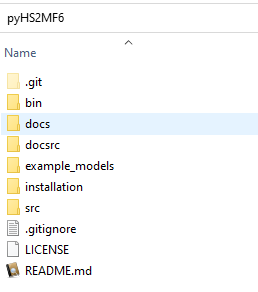2. Installation¶
pyHS2MF6 installation and configuration includes a number of steps, enumerated below.
Obtain or download the pyHS2MF6 directories and files from the GitHub site as a zip file archive.
Unzip this file to a local directory on the computer where you will run pyHS2MF6.
In the remainder of these instructions this directory is referred to as the pyHS2MF6 directory. The pyHS2MF6 directory should have the structure shown below.

pyHS2MF6 GitHub archive directory structure¶
The pyHS2MF6\bin directory contains the executable files or program files that comprise the program. In the bin root there should be four Python source code files with the extension .py.
The pyHS2MF6\bin\mHSP2 folder contains the eight Python source code files that compose the mHSP2 program.
pyHS2MF6\bin\pyMF6 folder contains three Python source code files and two dynamic-link library (DLL) files. One file has a .dll extension and the other has a .pyd extension.
Install and configure the Python 3 interpreter. This iteration of pyHS2MF6 has only been tested with Python 3.8. The mHSP2 source has been tested with Python 3.8.5 and 3.8.10. It is recommended to use Python 3.8.10.
Recreate the DLL files, if needed. This iteration of pyHS2MF6 is designed to be compiled with MODFLOW 6.2.1.
Configure the firewall to allow for message passing between the three independent processes used in a coupled mode simulation.
There are three firewall ports that need to be opened. One port for each message passing queue.
To HSPF queue
To MODFLOW 6 queue
Error handling queue
Caution
There is also an authorization key or pass code that is set by the user for queue access.
Section Contents